Germany has an extensive coastline in the north and some of it to the west fronts onto the North Sea, yet a slightly longer stretch east of Denmark faces out to the Baltic Sea. Although this may not be your first choice for a beach holiday, that would ignore the fact that there are several fine beaches in Germany, both on the mainland and offshore islands. The islands in the North Sea are a continuation of those off the Netherlands coast and are collectively known as the Frisian Islands.
There are inland beaches by lakesides that have become popular with locals. They include German beach escapes from the capital Berlin and even one down south in Bavaria, which locals regularly visit in the summer. If you are in either city when the weather is good, you are welcome to join them. Germany’s northern coastline has warm, if not hot, summer temperatures. You can expect around 20C (68F) as an average through the main summer holiday period.
Contents
20 Beaches In Germany
German Beaches – North Sea Islands
1- Westerland Beach, Sylt
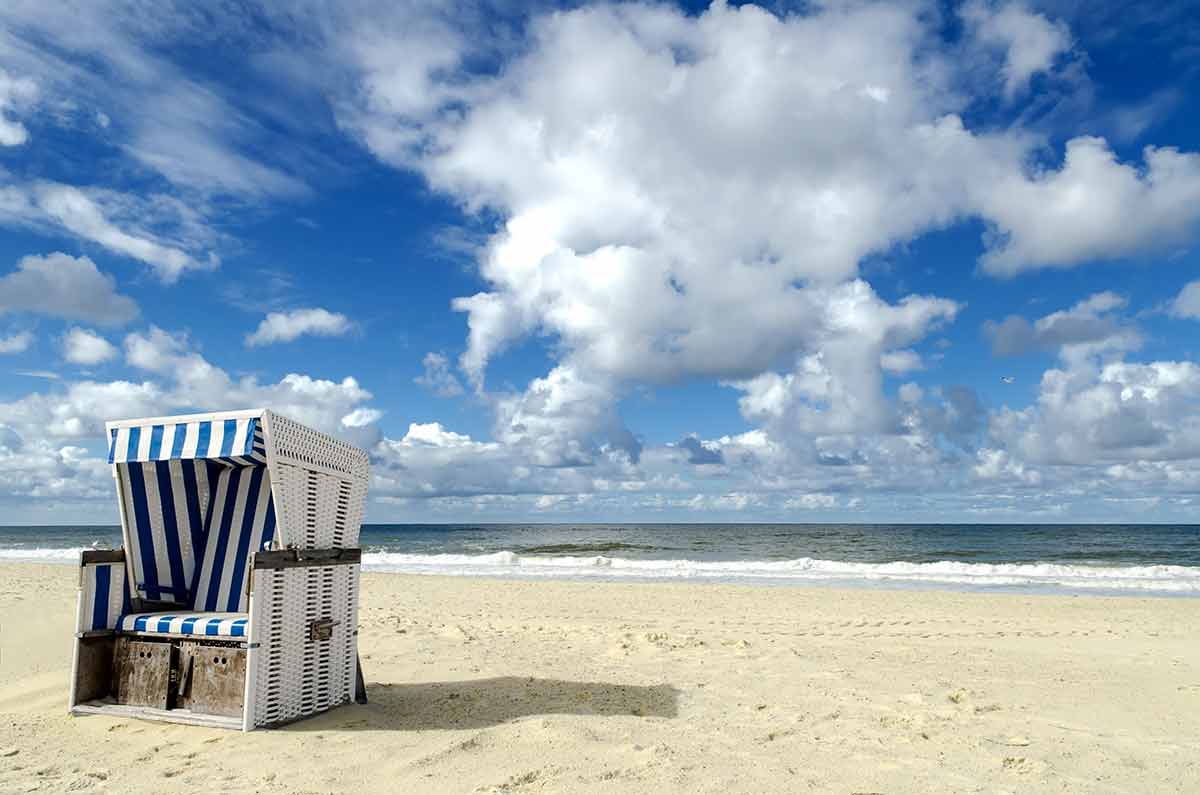
The island of Sylt experiences fresh sea breezes while visitors will also meet with red cliffs, a green landscape and long stretches of sand.
It is the largest of the North Frisian Islands and accessed by car ferry from Romo or via a causeway by rail.
Westerland is the island’s capital and the largest resort on Sylt. It faces west into the North Sea.
The island’s economy depends greatly on tourism, with an annual figure of 2.5 million overnight stays.
The promenade stretches six kilometres along the beach, with 4,000 beach chairs designed to protect from the winds.
2- Juist
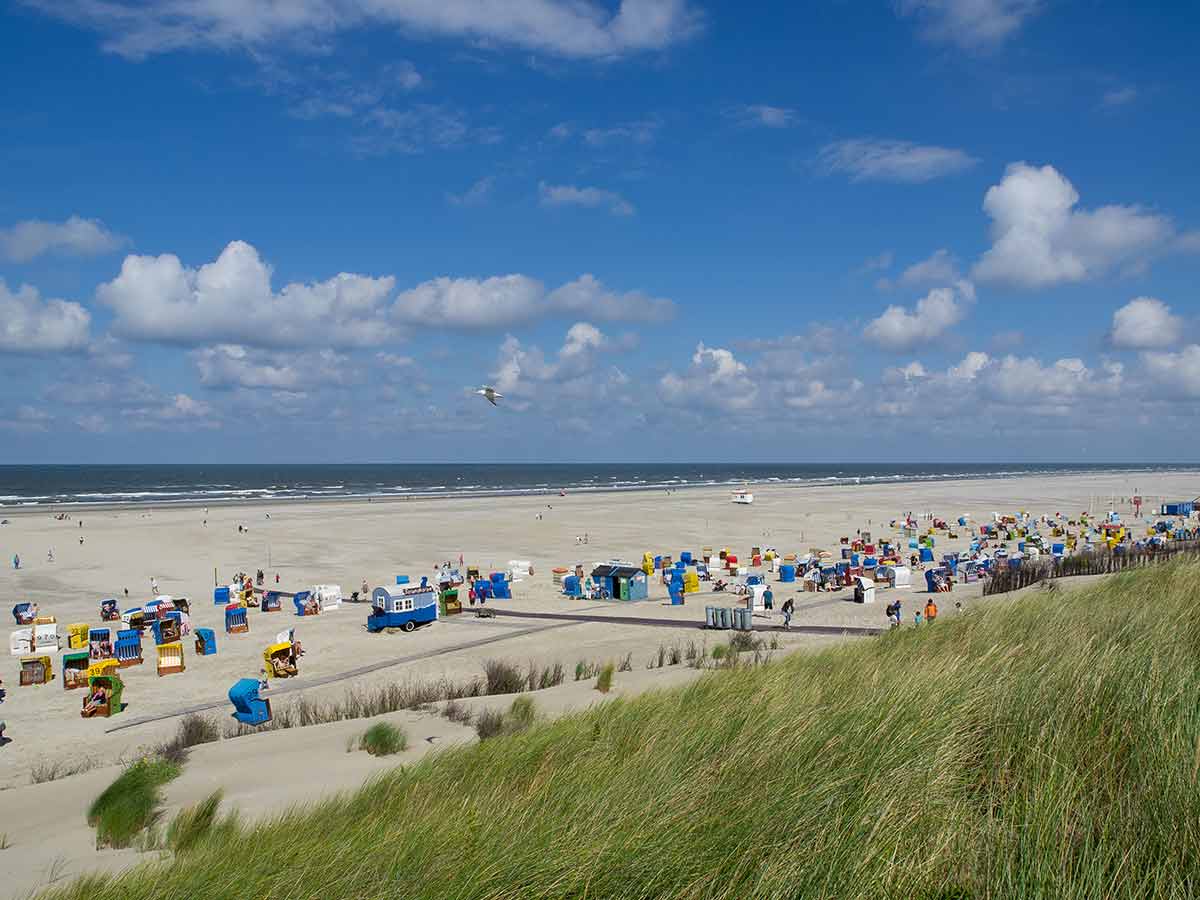
Juist is the most westerly of Germany’s islands. Its beach and dunes are prone to erosion, with the dunes seemingly moving each year.
The island’s economy revolves around tourism, with the sands being the main attraction.
The Fire Department, doctors and the Red Cross have the only vehicles on the island which is small enough to get around without the need for cars.
Tractors need a special licence.
Everyone else needs a bicycle or a horse-drawn carriage. Access to Juist is by ferry or plane; unmanned drones are now doing deliveries.
3- Langeooger
This island, translated into English as “Long Island”, is one of seven inhabited Eastern Frisian Islands.
Its 14-kilometre (9-mile) stretch of sand is stunning.
Indeed, geologically, Langeooger is pure sand; over the years, the island continues to move east, as do most of the Eastern Frisian Islands.
There is an airport on Langeooger, but regular transport is the ferry.
Vehicles are restricted to fire and medical services, even police and doctors use bicycles.
Cycles and horse-drawn taxis are the way for visitors to get around.
Guest rooms are readily available, with tourism central to the island’s economic wellbeing.
For more about Germany, read:
- 20 German Shows On Netflix
- 22 Famous Landmarks in Germany
- 15 Magic Things To Do In Munich
- 25 Facts About Germany
- 20 Castles In Germany
- 10 Bavarian Castles
- 20 Drinks In Germany
- Best Time To Visit Germany
- Berlin Nightlife
- Munich Nightlife
- 20 German Cities
- 20 Things To Do In Stuttgart
- 20 Things To Do In Cologne
- 20 Things To Do In Dusseldorf
- Where To Stay In Berlin
- 20 Types of Food in Germany To Taste
- 15 Famous Things Germany is Known For
- 20 Things To Do In Dresden
- 20 Things To Do In Frankfurt
- 20 Things To Do In Leipzig
- 20 Things To Do In Bonn
- 20 Things To Do In Bremen
- 20 Things To Do In Potsdam
- 20 Things To Do In Regensburg
German Beaches – Baltic Sea Islands
4- Binzer Strand, Rugen
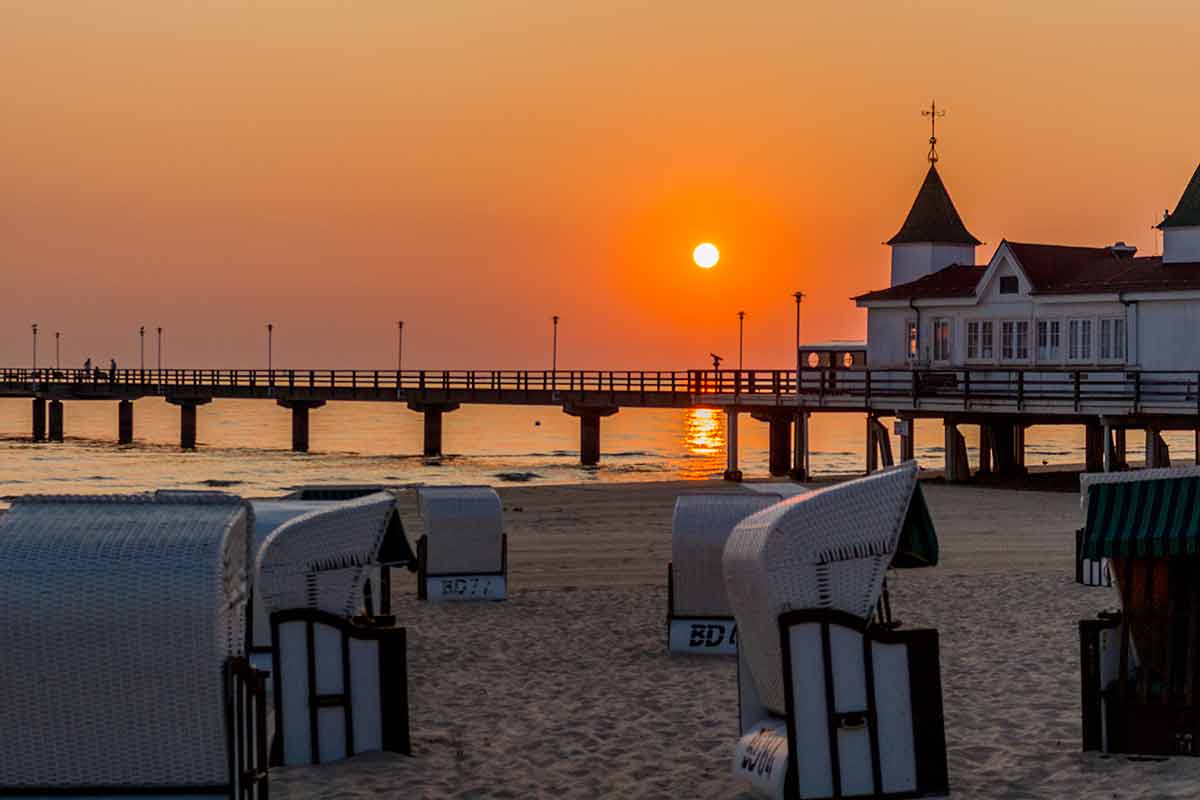
Binz is a small resort on Rugen Island in the Baltic, an island known for its beaches and white chalk cliffs.
Rugen is approximately 51 km by 43 km (32 miles by 27 miles) and has 575 km (356 miles) of coastline.
Not surprisingly, there are several beaches to choose from.
Rugen is towards the east of Germany and links to the mainland by road and rail.
There are also regular car ferries between Sassnitz to neighbouring countries, Denmark, Lithuania, Sweden and Russia.
The airport offers sightseeing trips over the island and some international connections.
With such easy access, it is no surprise that Rugen is popular with tourists.
UNESCO World Heritage Jasmund National Park is home to white-tailed eagles amongst the beech trees.
Sassnitz, east of this park, is the main resort where you will find the submarine, HMS Otus, now a museum.
Binzer was the second resort to develop in the east of the island. It is also on the east coast, south of Sassnitz.
5- Sellin Beach, Rugen
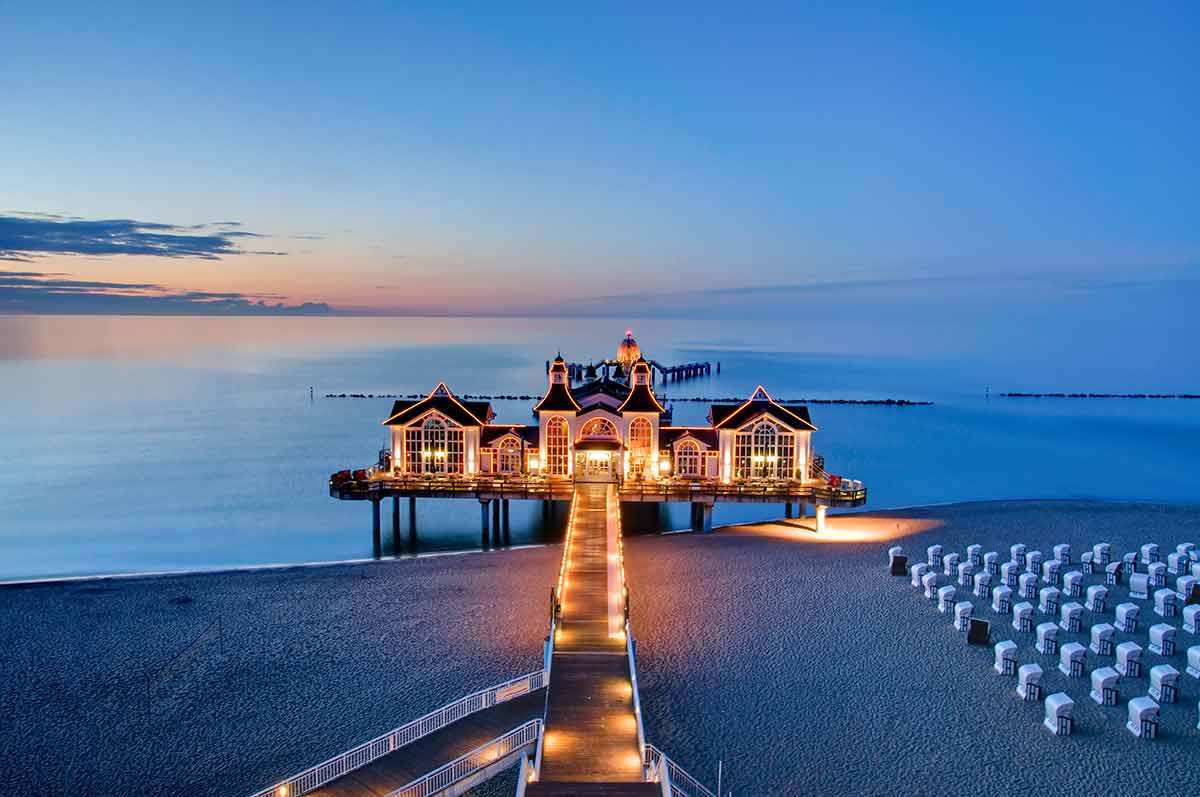
Further down the east coast from Binz, there is Sellin, known for its pier that dates back almost a century.
You can take a break from the sands to have lunch there though, in high season, you may find it quite crowded.
The restaurants are good quality once you leave the sands and the sandcastles that the kids built.
Boutique hotels are plentiful but be sure to book in advance during high season.
You can cycle between Binz and Sellin quite comfortably.
6- South Beach, Fehmarn
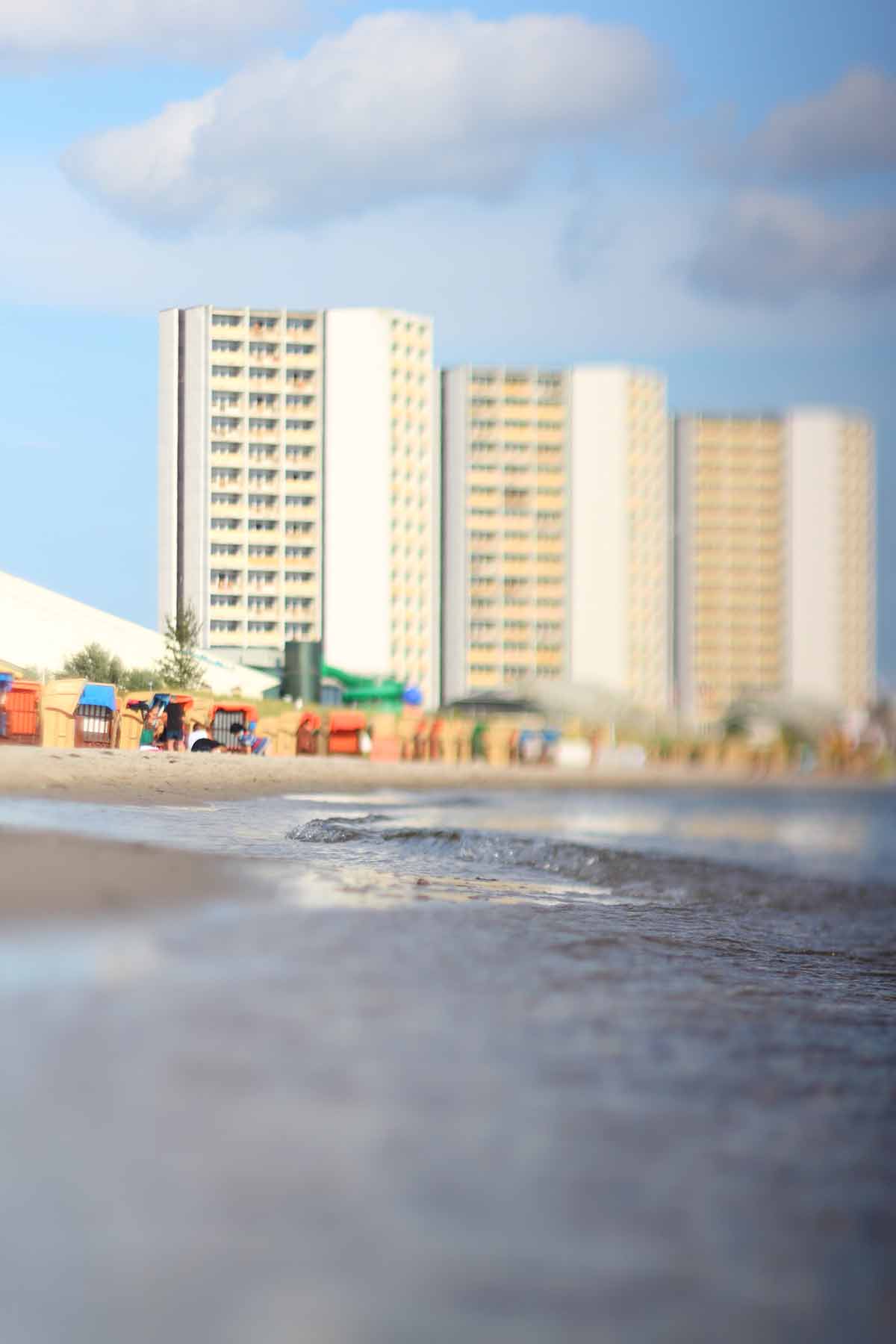
Fehmarn is a small island with Burg as its main settlement, a population of 6,000, and several small villages.
Ferries link with the mainland as well as Denmark, a bridge links to the mainland, and a tunnel project may make access even easier.
The beaches are wonderful, while this is also a great place for kitesurfing and windsurfing.
Birds and marine life add to its attraction.
There are apartments on South Beach to rent should you want independence and good tourist infrastructure to provide a good holiday.
7- Hiddensee
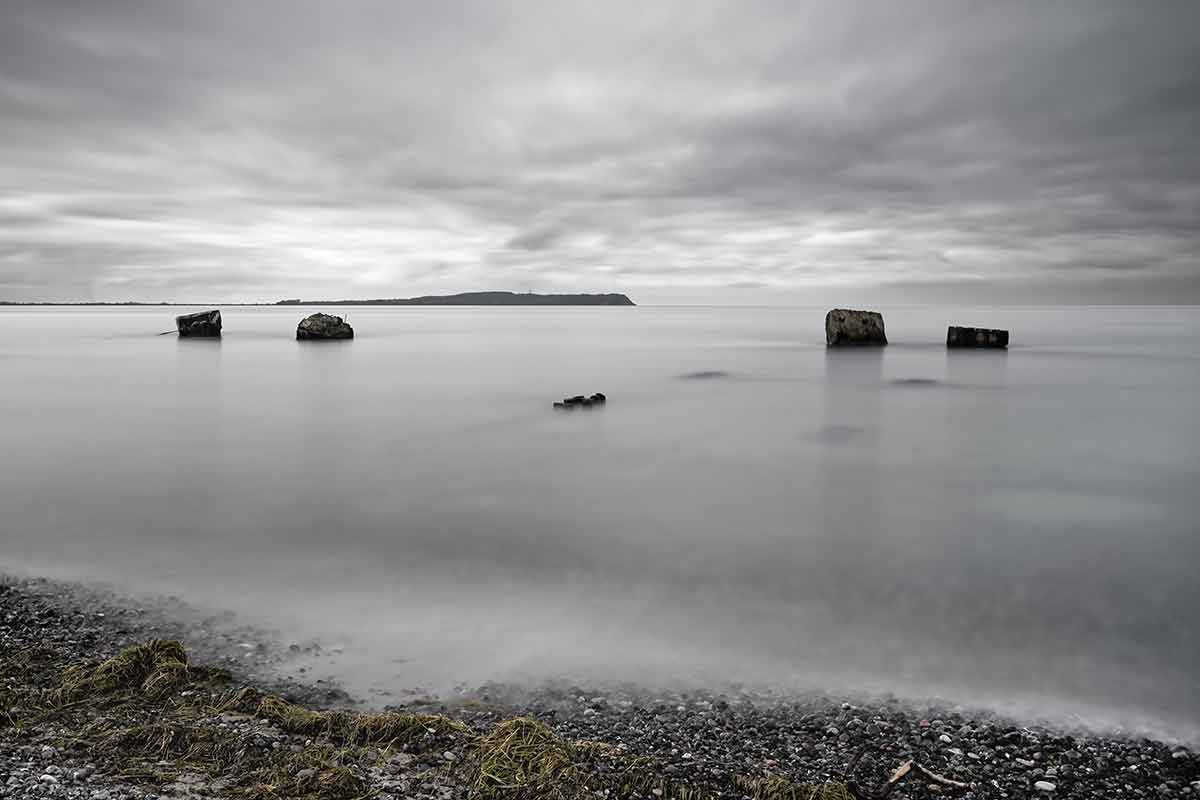
This island sits west of Rugen, car-free yet with a population of around 1,000.
Its German name is fairly recent, originally being named after the Norse king, Hedin as Hedinsey “Island of Hedin.”
It was extremely popular with East Germans when the country was divided.
It’s not even 4 km (2.3 miles) at its widest point, west to east and 250 metres (800 feet) at its narrowest. North to south, it measures 17 km (10.5 miles).
It is an island of heathland and dunes. Ferries and water taxis bring visitors to the island.
8- Ahlbeck Beach, Usedom
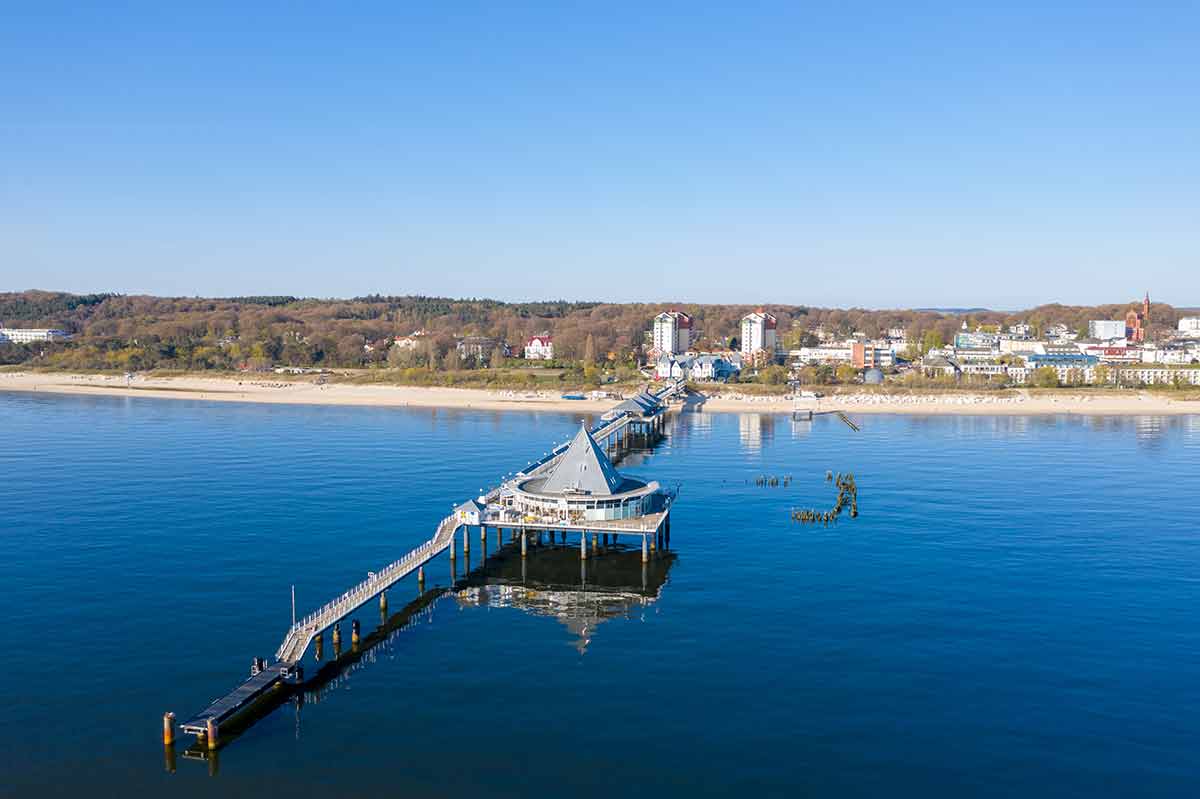
Ahlbeck was popular with German royalty in days gone by, and there remains a feeling of old-fashioned luxury about the place.
The promenade and old pier are significant landmarks.
When the wind blows, it is easy to think that the noise created is similar to a song.
You’ll find plenty to do and refreshments readily available.
There are rail connections to Usedom from everywhere in Germany, and Poland is just close by.
Not surprisingly. Ahlbeck can be busy in the high season.
Best German Beaches – North Sea Coast
9- Nordseestrand Neuharlingersiel
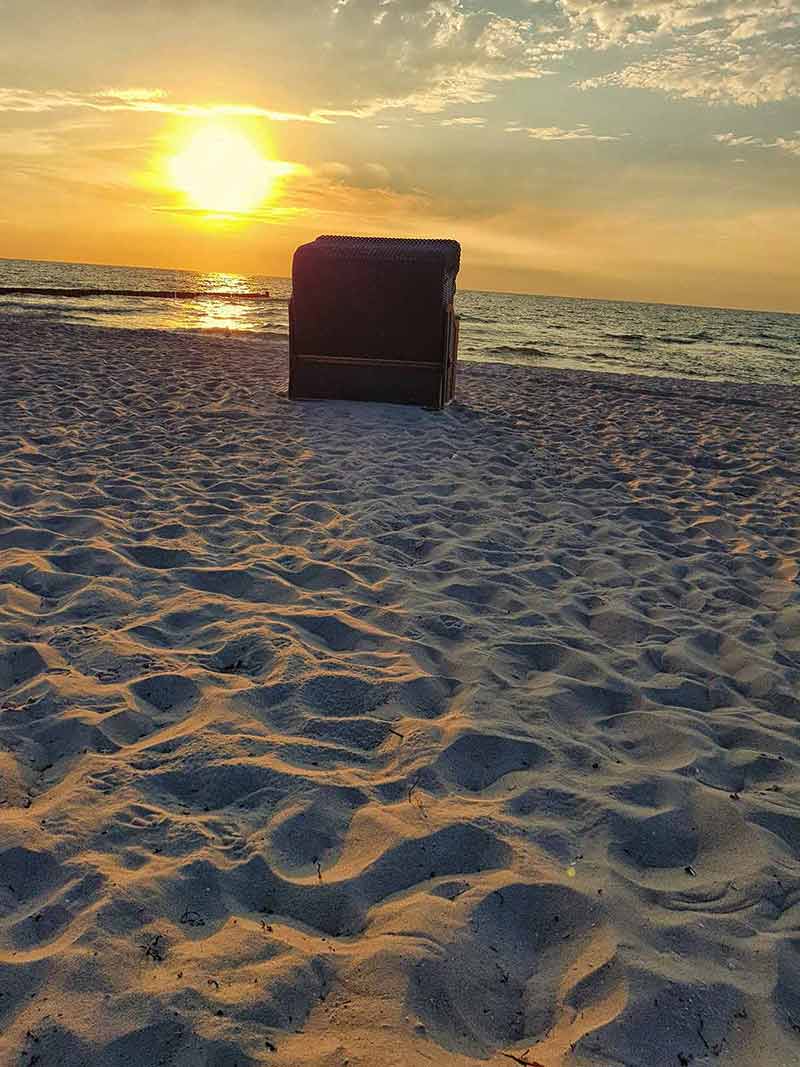
This tongue twister is a great place for both relaxing and seeking an adventure.
Swimming and surfing, joining in team games or just relaxing are part of the scene.
Safe swimming is important to families with children, and Nordseestrand deserves its reputation as one of the safest.
It has lifeguards checking throughout the day in case of problems.
An area is set aside for games, so they do not intrude on beachgoers who are not participating.
Bars and restaurants cater for everyone who visits this lovely stretch of sand.
10- Ording Beach
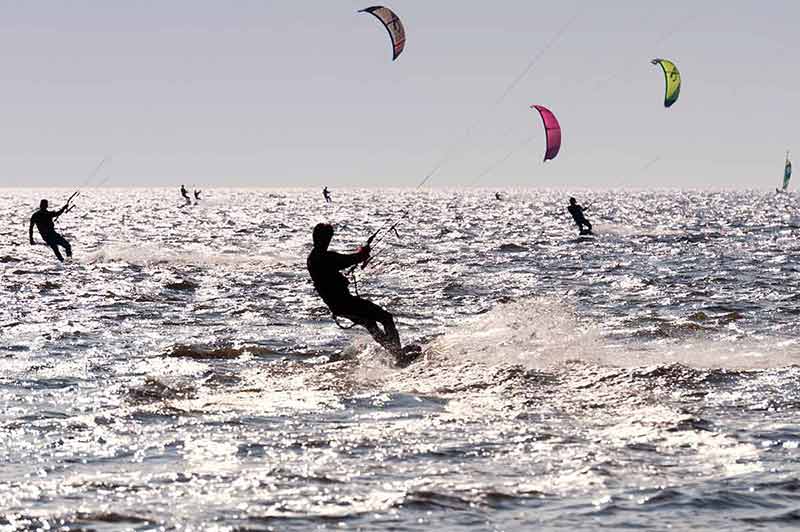
This beach in St. Peter-Ording provides a great getaway.
The sulphurous springs led to several wellness centres and spas opening. Add the huge stretch of sand, and Ording has become a popular place for those wanting a relaxing holiday.
That said, it is also a place that attracts surfers.
There are good facilities here with parking and toilets as well as bars and restaurants.
There is ample accommodation close to the beach with additional attractions, including the museums.
Just enjoy the fresh air, and perhaps go collecting sea urchins? It’s your holiday.
11- Schonberger Strand
Few places on Germany’s North Sea coast offer such good swimming as Schonberger.
Small dunes line the sands to produce a lovely natural setting.
If you plan on relaxing on the sand, do so, but there is much more to keep you active.
Stroll the 7 km (4.5 miles), but for exercise, why not try kayaking, paddle boarding or surfing?
There is a long pier, all 260 metres (850 feet) of it.
The museum is interesting, as is the old windmill if you want to walk around away from the beach for a time.
Accommodation includes hotels, apartments and guest houses.
German Beaches – Baltic Sea Coast
12- Lubmin
Lubmin Beach in Griefswald is a nice stretch of sand with cliffs and pine forests adding to the setting.
This beach in Germany offers plenty of activities, from fishing to horse riding, and hikers can find some lovely walks.
Lubmin is also famous as a nudist beach though that is not compulsory.
It remains a secret from international visitors to this day, but things will surely change.
With Hamburg Airport reasonably close, there is no reason why visitors should not increase.
To date, there is limited accommodation, reflecting its relative secrecy, so book in advance if you intend to stay.
13- Timmendorfer Strand
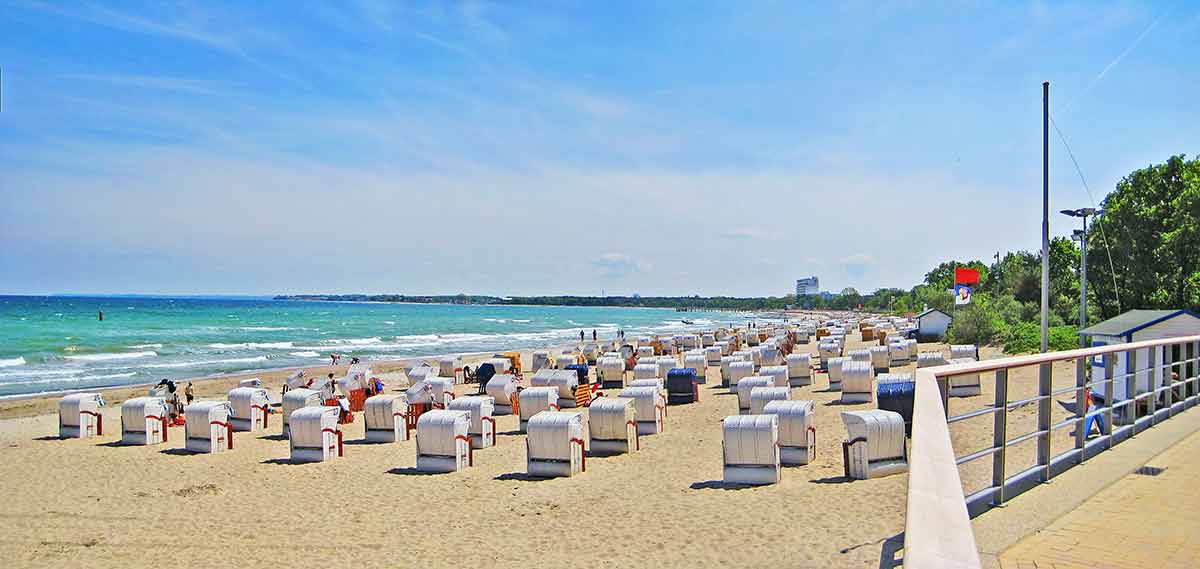
This beach at Niendorf near Lubeck remains a secret to mass tourism, but the locals know all about it.
The beach itself, 6 km (nearly 4 miles) is fairly lively with volleyball, beach football and regular concerts, as well as the chance to relax.
The pier stretches well into the sea, a significant island landmark.
The local wildlife park, filled with exotic birds, is a great day out if you want time away from the beach.
You’ll find apartments for rent, a few large hotels, some top quality, and guesthouses.
14- Warnemunde
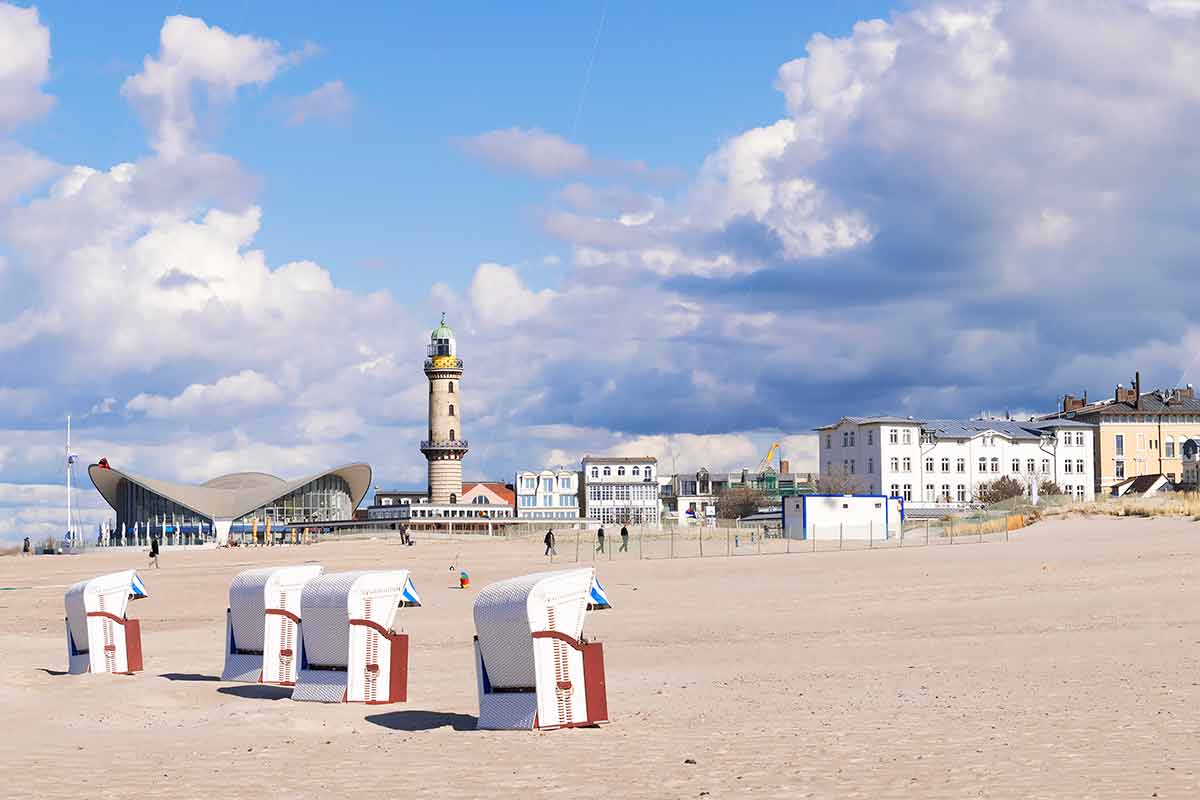
The proximity of Rostock, a busy cruise terminal, to Warnemunde was always going to make this beach popular.
Families find its attractions and fun activities appealing, with plenty of accommodation and eateries available for visitors.
A marina caters for those wanting a day at sea, and the shallow water makes it an excellent choice of beach in Germany for those with young children.
You can climb the 19th-century lighthouse and look down over the island and its surroundings.
15- Kuhlungsborn
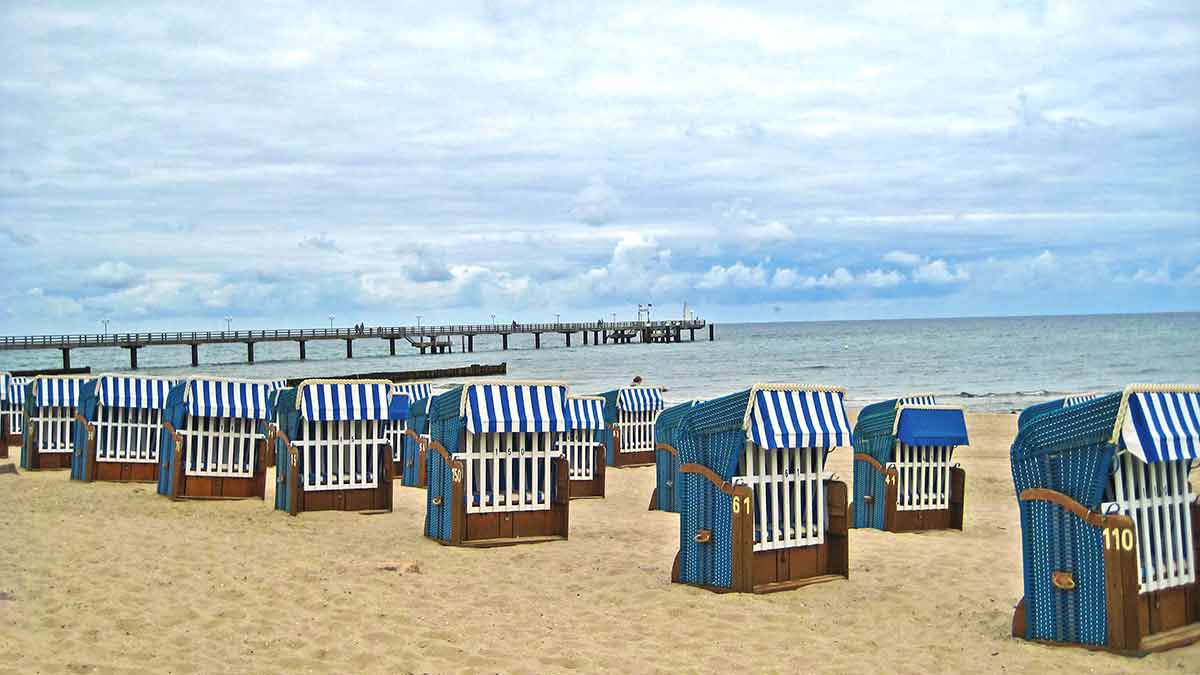
This resort town on the Baltic is famous for its beach and pier.
A promenade lines the beach behind which sit villas, there since the early 1900s.
The town has just 7,000 inhabitants, but that swells in the season as visitors aim for the beach.
Rostock is nearby, providing a readymade audience for the beach and facilities.
Spa treatment saw the emergence of Kuhlungsborn during the mid-19th Century, and today’s steam train reminds everyone of those days.
The long pier stretches for 240 metres (790 feet), and today’s structure replaces the wooden ones crushed decades before by ice.
16- Eckernforde Hauptstrand
It is the panoramic view of the beach in a 16 km (10 miles) bay that brings home the beauty of this place.
The beach measures 4 km (2.3 miles) and comprises beautiful white sand.
There are cafes and shops along the beach, which is ideal for kids.
Sports equipment is available for hire, and team games regularly take place on the beach, or just hire a chair and umbrella for shade.
Relax, enjoy a swim or possibly snorkel.
German Beaches – Inland Lakeside
17- Sacrower See, Brandenburg
This lake near Potsdam in Brandenburg measures 2.8 km (1.7miles) by 400 metres (1330 feet).
It sat on the border that isolated West Berlin during the Cold War.
It is popular with hikers who can get shades from the forest, even in mid-summer when even more people enjoy swimming in its waters.
There are a series of small beaches which do fill up, especially on summer weekends.
The water is deep, so it is essential to keep an eye on children.
18- Wannsee, Berlin
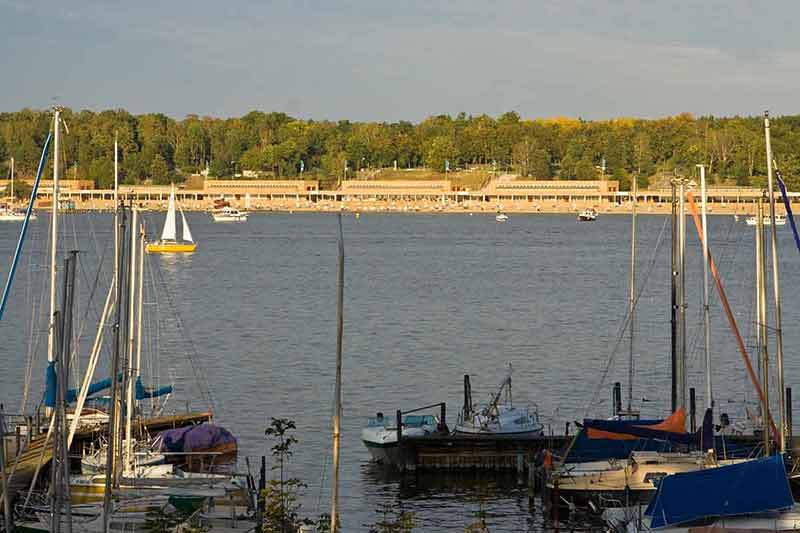
Wannsee Lake is the largest in the region around Berlin.
It attracts plenty of locals on warm weekends, some wanting to sail but others just wanting to stretch out on the beautiful white sand.
Wannsee is 150 metres (250 feet) wide and 1200 metres (4,000 feet) long and not tidal.
Swimming in the lake is just one of the available activities.
Cruise or sail or simply stretch out on the sand.
There are plenty of places for food and drink, a playground, toilets and showers.
19- Muggelsee, Berlin
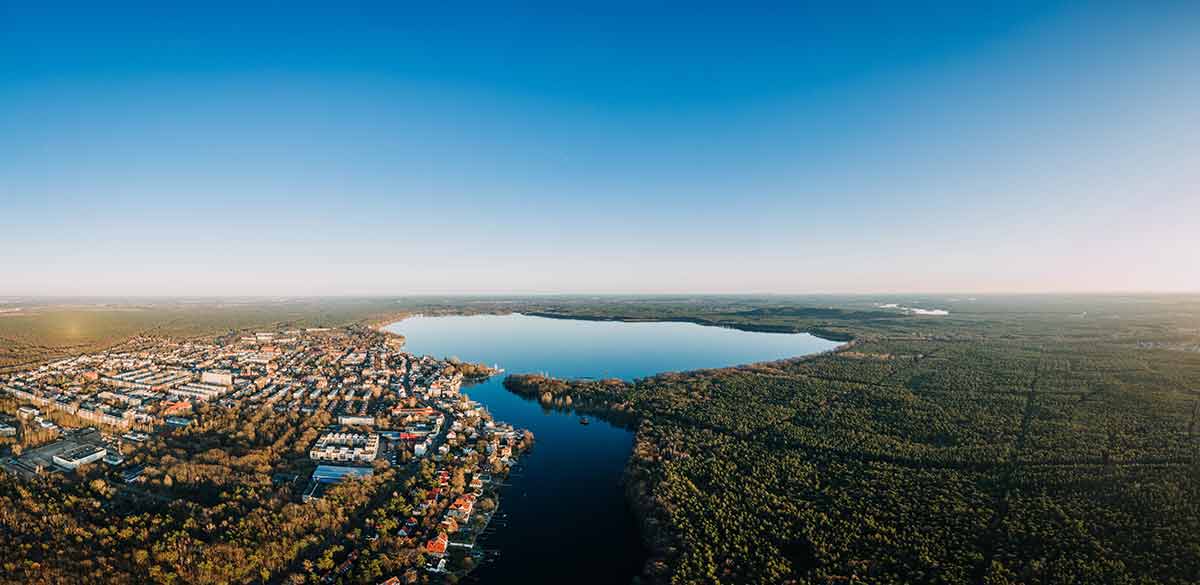
This natural lake is on the eastern edge of Berlin, covering 7.4 square kilometres (2.85 square miles).
It is eight metres (26 feet) to the bottom at its deepest point.
The view from the tower over the lake is worth seeing, even if you just go there to relax.
While you would not want to sunbathe in winter, the lake still attracts visitors keen to walk through the forests where it is very tranquil.
There are three designated swimming areas, and boats are available for rent.
Additional attractions include the museum in Wasserwerk on the north ban and the small fishing town of Rahnsdorf in the south-east.
20- Alpseebad Hohenschwangau
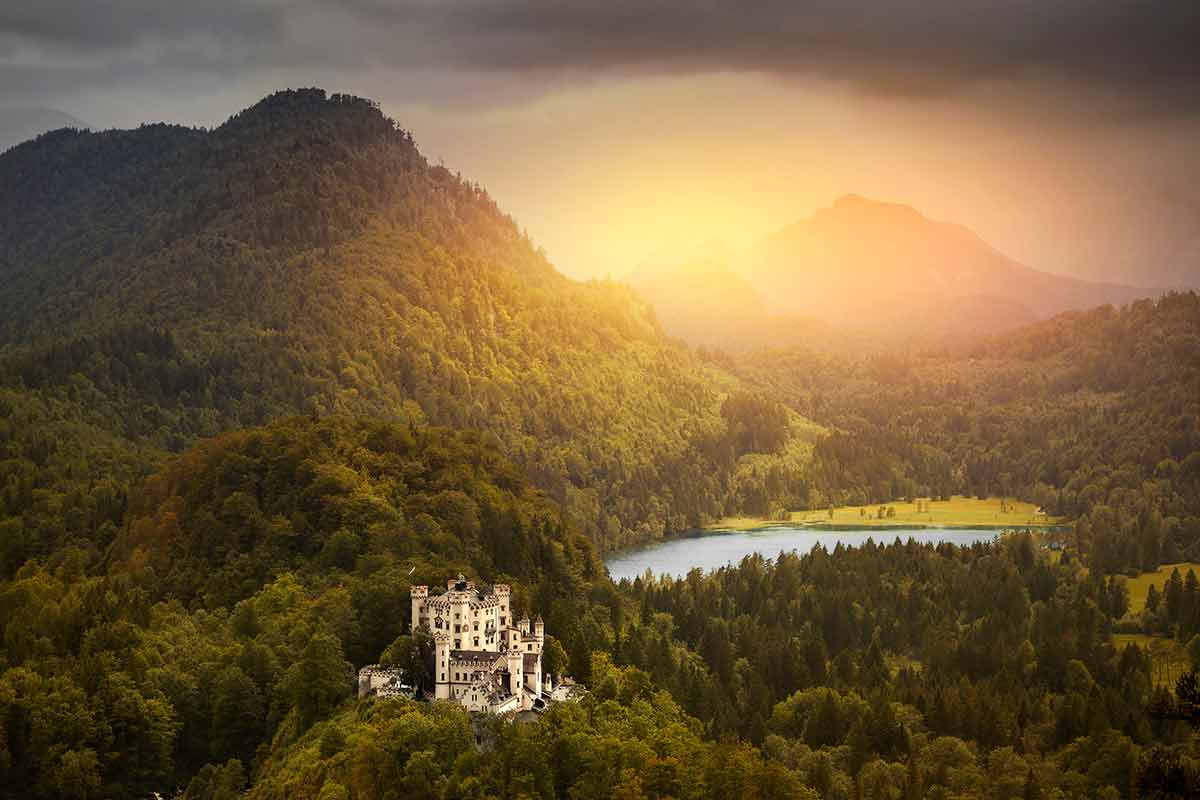
This Bavarian Lake is just south-east of Fussen in Bavaria, close to the border with Austria.
The beach is just one of the attractions of Alpseebad because it has castles nearby and wild swans live there.
The castles date back to the early 19th Century when the region became part of Bavaria.
The shoreline of the lakes is just 5 km (just over 3 miles), but it is an impressive 62 metres (200 feet) deep.
There are boats for hire and well-established hiking trails, including a path around the lake.
For more beaches around the world read:
- 20 Places For Christmas On The Beach
- 20 Sunshine Coast Beaches
- 20 Best Beaches In Italy
- 20 Best Beaches In Spain
- 12 Beaches In Australia
- 20 Nordic Beaches
- 21 Longest Beaches In The World
- 20 Best Beaches In Egypt
- 20 Best Beaches In Asia
- 20 Best Beaches in China
- 20 Indonesia Beaches
- 20 Best Beaches In Vietnam
- 20 Dominican Republic Beaches
- 21 Malaysia Beaches
- 20 Cambodia Beaches
- 20 Maldives Beaches
- 20 New Zealand Beaches
- 20 Beaches In Illinois
- 20 Utah Beaches
- 20 New Mexico Beaches
- 20 Florida Keys Beaches
- 20 Venezuela Beaches
- 20 Arizona Beaches
- 20 Barbados Beaches
- 20 Hawaii Beaches
- 20 Ecuador Beaches
- 20 Beaches In Texas
- 20 Cayman Islands Beaches
- 20 Costa Rica Beaches
- 20 Argentina Beaches
- 20 Guatemala Beaches
- 20 Grenada Beaches
- 20 Beaches In France
- 20 German Beaches
- 20 Portugal Beaches
- 20 India Beaches
- 20 Malta Beaches
- 20 Curacao Beaches
- 20 North Carolina Beaches
- 20 South Carolina Beaches
- 20 Taiwan Beaches
- 20 Honduras Beaches
- 20 Greek Beaches
- 20 New Jersey Beaches
- 20 San Francisco Beaches
- 20 Beaches in Perth
- 20 Mississippi Beaches
- 20 Fiji Beaches
- 20 Black Sand Beaches
- 20 Tampa Beaches
- 20 Best Beaches In Mexico
- 20 Best Beaches In Sri Lanka
- 20 Beaches In South Korea
- 20 Best Beaches In Japan
- 10 Beaches In Tasmania
- 20 Best Beaches In Cuba
- 20 Best Beaches In Colombia
- 21 Best Beaches In Canada
- 20 Best Beaches In Wales
- 20 Best Beaches In Scotland
- 20 Beaches In England
- 21 Seattle Beaches
- 19 Kenya Beaches
- 20 Beaches In Tennessee
- 21 Oregon Beaches
- 21 Jamaica Beaches
- 20 Chile Beaches
- 20 Best Beaches In South America
- 20 Beaches In Maine
- 20 Wisconsin Beaches
- 20 Massachusetts Beaches
- 20 New York Beaches
- 20 Beaches In Brazil
- 20 Beaches Turks and Caicos
- 20 Haiti Beaches
- 20 El Salvador Beaches
- 20 Best Beaches In UK
- 20 Beaches In Virginia
- 20 Turkey Beaches
- 20 Nicaragua Beaches
- 20 Connecticut Beaches
- 20 Aruba Beaches
- 20 Panama Beaches
- 20 Seychelles Beaches
- 20 Anguilla Beaches
- 20 Trinidad Tobago Beaches
- 20 Mauritius Beaches
- 20 Sicily Beaches
- 20 Croatia Beaches
- 20 Georgia Beaches
- 16 New Hampshire Beaches
- 20 Belize Beaches
- 20 Uruguay Beaches
- 20 French Riviera Beaches
- 20 Alabama Beaches
- 20 Mykonos Beaches
- 20 Dubai Beaches
- 20 Philippines Beaches
- 23 Melbourne Beaches
- 13 Singapore Beaches
Plan Your Trip

Rent A Car – Find the best car rental rates at Discover Cars. They compare car hire companies to provide you with the best deal right now.

Find A Hotel – If you’re curious about this article and are looking for somewhere to stay, take a look at these amazing hotels.

